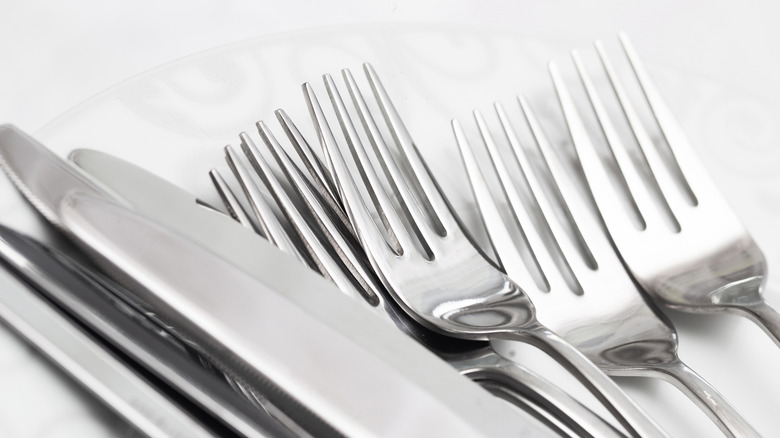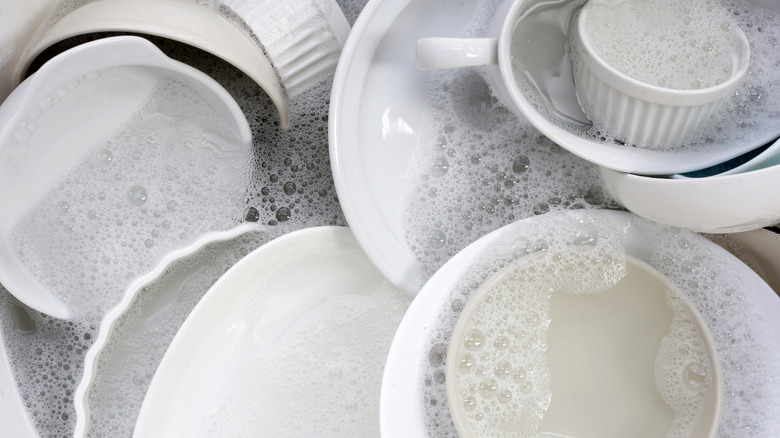Restaurant Silverware Is Dirtier Than You Think
If you catch a stomach bug after eating out, you're probably quick to blame the burger. But science says that nasty noroviruses don't always hide in the places that you'd expect. According to a 2012 study, the real culprit could be your cutlery. The study found that norovirus — the most common cause of foodborne illnesses in the United States — can stick to dishes even after a run through the dishwasher. It's not necessarily the restaurant's fault, either. Standard washing procedures simply aren't enough.
Researchers added Listeria, E. coli, and norovirus (three common food-borne pathogens) to dairy products. Then, they smeared samples on plates, forks, and cups. They used dairy because dairy products are particularly difficult to clean: they wanted to test the "worst case scenario" while keeping things realistic.
After giving the dishes time to dry (so removing the dairy would be extra difficult), researchers ran them through the wash. Some of the dishes went through a commercial dishwasher, while others got a manual wash. While washing got rid of the E. coli and Listeria for good, norovirus stuck around. The amount was small, but enough to get someone sick. "Norovirus is highly contagious and it takes only a few viral particles to infect humans," Jianrong Li, one of the study's authors, told Science Daily.
How much should you worry about restaurant silverware?
Don't let this make you give up restaurants for good, though. Remember, researchers said they were testing the "worst case scenario" while sticking to standard protocols. In addition to specifically testing sticky foods, they used a low-temperature dishwasher. The dishwasher in the study only reached 120 degrees Fahrenheit, but many commercial dishwashers go up to 180 degrees — more than enough to kill off norovirus. A study published in 2023 used higher temperatures to test other common viruses, including Murine Norovirus, Hepatitis A, and human coronavirus 229E. The results? The viruses couldn't handle a dishwasher rinse at 155 degrees.
Plus, there's an upside. Both dishwashers and hand washing were able to get rid of nasty bacteria. "We know that when public food establishments follow the cleaning protocols, they do a very good job at getting rid of bacteria," Melvin Pascall, another author of the 2012 study, told Science Daily. Scientists stress that bacteria and viruses are part of life: you'll never be able to get rid of them completely. While you should trust your gut if a restaurant has dirty tables and floors, feel free to give it a go if it looks clean. After all, the kitchen staff is doing their best to keep those dishes clean.
How to stay safe at home
Your home can be a hotbed for norovirus, too. Normally, you shouldn't have to worry — but you can take extra steps if someone in your household has a stomach bug. Home dishwashers don't always reach the same high temperatures as commercial ones, so check your manual to see if your dishwasher can reach 145 degrees. If not, you can sanitize dishes by submerging them in hot water for 30 seconds.
Ideally, the water should be 170 degrees. That's hot enough to ensure your dishes are sanitized, without veering too far outside standard dishwasher range. No thermometer? You can gauge water temperature by the size of the bubbles that form along the sides of plates and bowls. Water should be around 170 degrees when medium-sized bubbles start to pop up. Once you've soaked your dishes, carefully remove them with gloves or tongs and let them air dry completely. Remember to sanitize the rest of your home, too. You can always check the CDC's guidelines for preventing norovirus. Whether you're dealing with a virus or not, it's always a good idea to clean your dishwasher.


